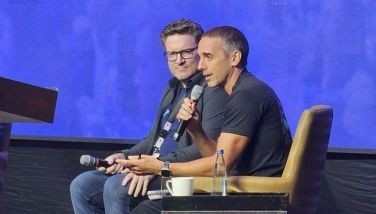Push a button, get a ride: Uber’s take on urban mobility
MANILA, Philippines - Uber was hogging global headlines last week and not in a very nice way, but a whiff of fresh air came to town via its regional general manager for Asia-Pacific and Latin America Andrew Macdonald, who was described by Business Insider as one of the “power players“ at Uber.
At the game room of Uber’s Manila office, the executive who was visiting Manila for the first time talked about getting a taste of EDSA traffic and having lunch at a local fastfood chain.
“I learned something today – there are close to 13 million trips (12.8 million to be exact) a day on EDSA, 31 percent of these from private cars, and 70 percent of road space occupied by private cars. Most cars have single passengers,” he says as a sort of an icebreaker.
He says he views this as “very relevant statistics to anchor for the future of mobility.”
Uber’s “push a button, get a ride” concept has resonated well with the Filipino commuting public that it now has 600,000 active users in Metro Manila.
Macdonald couldn’t be happier about that. If what he says is true that ride-sharing services are thriving even in cities with very efficient public transportation systems like New York and Singapore, how much more in Mega Manila where commuters face the daily prospect of hanging by the rear of a smoke-belching jeepney or getting conveniently squeezed to perfection in a jampacked train.
But it isn’t about how convenient it is for the Philippines to embrace ride-sharing that he wants to talk about. He wants a conversation on the future of urban mobility.
Optimism
“Our research shows that there’s a lot of optimism in solving our mobility challenges. When we talk to our rider base, what we hear are advances in transportation enabled by technology. We share that optimism,” he says.
One of Uber’s solutions to urban congestion is Uber Pool. Macdonald explains that at any given time or any given route, there will be two or more trips starting near each other and that happens around the same time.
“What Uber Pool does is it uses data and algorithms to combine those two trips into one. So, if we can turn two trips into one, there’s a ton of benefits to society. It benefits riders because we are able to bring the price down and it benefits drivers because they spend more time on each trip. For cities, it’s able to turn the work of two cars into one car,” he says.
To date, he says the service already has a measurable impact: 1.5 million kilometers and 75,000 liters of fuel saved.
A recent study International Transport Forum affirms that with advancements in ride-sharing, there could be a reduction in traffic emissions due to less congestion, 50 percent more savings on shared rides, and public space required for parking would be drastically reduced by about 95 percent.
Thus, he says, Uber research shows that there is more optimism in the future of urban mobility. The same study shows that when asked about their views on transportation, 82 percent of respondents said they believe advances in tech-enabled transportation services will make it possible to rely less on a car or even go car-free.
Eighty-eight percent of the respondents also believe that carpooling will be more convenient, while 94 percent said they see connectivity between public and private transportation modes as improving. More importantly, 90 percent said they believe the overall quality of commuting in Metro Manila would also improve.
Going Multi-Modal
A data map of Uber trips in Manila in October 2016 shows that these trips are quickly expanding to the fringes, which means more people using the service to locations previously underserved.
Local research shows that Filipino users are using multiple modes of transportation on a day-to-day basis: MRT/LRT (27 percent), bus (26 percent), shuttle service (17 percent), jeepney (40 percent), ride-sharing/transport network services (9 percent), taxi (34 percent), walking (34 percent), motorbike (3 percent), private car (49 percent), bicycle (1 percent), tricycle (21 percent), and pedicab (2 percent).
“When you think of how ride-sharing interacts with other modes of transportation, it’s actually complementary because people use different modes of transportation,” he says.
This means that riders can use Uber or other TNS services to get to one destination but use another mode of transportation to get to the final destination.
“Ride-sharing is not displacing any other mode of transportation. People will always gravitate towards what is most affordable, most reliable, and most convenient for them,” he explains.
Competition And Diversity
Understandably, Uber is not the only player in the ridesharing space. But the Uber executive isn’t worried. “As a consumer, I love competition. I think it’s great for cities, for consumers, and for drivers as well because it means lower prices for consumers, higher demand for drivers, and more options for cities. It leads us to innovate. You will see more competition and innovations in the ride-sharing-space. We are just getting started,” he says.
Uber is particularly proud of bringing transportation to people who don’t have access to it, whether it’s about lowering prices, offering work at the push of a button, technology leveling the field by enabling drivers with different abilities to earn a living, or providing rides to people with limited mobility options such as persons with disabilities.
Its newfound vision: “Transportation as reliable as running water, everywhere, for everyone.”
- Latest





























